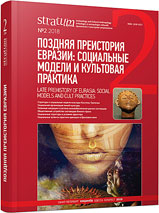Детские погребения лейлатепинской культуры эпохи халколита на поселении Галаери в Азербайджане: опыт биоархеологического исследования
Infant Burials of the Leila-tepe Culture of the Chalcolithic Age on the Settlement Galaeri in Azerbaijan: an effort of bioarchaeological study
Author(s): Maria B. Mednicova, Najaf Museibli, Sergej N. KorenevskijSubject(s): History, Archaeology, Ancient World
Published by: Издательский дом Stratum, Университет «Высшая антропологическая школа»
Keywords: Azerbaijan; Chalcolitic; Leila-tepe culture; infant burials; microfocus X-ray; palaeopathology; scurvy; strontium isotopic ratio
Summary/Abstract: Study of the Chalcolithic Leila-Tepe culture discovered in Azerbaijan gave strong evidence for Caucasian migration of ancient agriculturists from the Northern Mesopotamia starting from the end of the 5th mill. BC. Burial sites of the culture were mainly connected with infant burials in vessels inside multilayered settlements (tells). Our study was devoted to description of three burials from excavations of the settlement Galaeri (Beta 330265: 5060±30 BP or 3940—3800 BC, Museibli, 2013). All infants were buried in vessels of the same type made of rough ceramics. Studying skeletons, we estimated biological age, as well as parameters of physical development and palaeopathological features. Digital microfocus X-ray was used. Pilot study of strontium isotopes ratio by mass-spectrometry was provided (values 0.708618—0.708785), which indicated the growth of infants in common geochemical conditions. It should be stressed that the only control sample of soil from Galaeri settlement shows a little different signal (0.709389). That means, further research of control samples could support hypothesis of local/nonlocal origin of infants buried in these vessels. Two youngest infants (##3 and 6) died at 4—6 months. But their sizes were close to modern newborns. The third child, who demonstrated dental age about 4—5 years, was also retarded by 2—3,5 years. All infants from Galaeri site showed symptoms of chronical vitamin C deficiency. The data indicates the absence of fresh fruits and vegetables in diet of little children and their mothers.Study of the Chalcolithic Leila-Tepe culture discovered in Azerbaijan gave strong evidence for Caucasian migration of ancient agriculturists from the Northern Mesopotamia starting from the end of the 5th — late 4th mill. BC. Burial sites of the culture were mainly connected with infant burials in vessels inside multilayered settlements (tells). Our study was devoted to description of three burials from excavations of the settlement Galaeri (Beta 330265: 5060±30 BP or 3940—3800 BC, Museibli, 2013). All infants were buried in vessels of the same type made of rough ceramics. Studying skeletons, we estimated biological age, as well as parameters of physical development and palaeopathological features. Digital microfocus X-ray was used. Pilot study of strontium isotopes ratio by mass-spectrometry was provided (values 0.708618—0.708785), which indicated the growth of infants in common geochemical conditions. It should be stressed that the only control sample of soil from Galaeri settlement shows a little different signal (0.709389). That means, further research of control samples could support hypothesis of local/nonlocal origin of infants buried in these vessels. Two youngest infants (##3 and 6) died at 4—6 months. But their sizes were close to modern newborns. The third child, who demonstrated dental age about 4—5 years, was also retarded by 2—3,5 years. All infants from Galaeri site showed symptoms of chronical vitamin C deficiency. The data indicates the absence of fresh fruits and vegetables in diet of little children and their mothers.
Journal: Stratum plus. Археология и культурная антропология
- Issue Year: 2018
- Issue No: 2
- Page Range: 197-210
- Page Count: 14
- Language: Russian
- Content File-PDF

